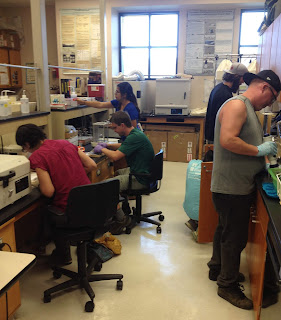Phoenix is one of the fastest growing cities in the United States. That means a LOT of people live in the city, which means a lot of fossil fuels are consumed. When we think about the environmental impacts of fossil fuels, we usually hear about carbon dioxide (which is a greenhouse gas and contributes to global warming and climate change). But that's not the only down-side to fossil fuels. Another form of pollution caused by burning fossil fuels is "nitrogen deposition".
When fossil fuels are combusted in, for example, a car engine, nitrogen compounds are released into the air. While these compounds are in the air, they go through chemical reactions and eventually fall back to the ground. This is one of the components of "acid rain", which you've probably heard of before. But here in the Sonoran Desert, it's a bit different. We don't have a lot of rain. So sometimes the nitrogen comes down in the rain, but sometimes it comes down in dry particles, kind of like dust. That's why we call it "nitrogen deposition". Deposition just means everything coming back down to the ground - it can be either wet (like rain or snow) or dry (like dust).
We know that the Sonoran Desert is receiving extra nitrogen deposition around Phoenix. How do we know? We measure it! Our research group (CAP-LTER) has many research sites inside and outside of Phoenix where we measure how much nitrogen is coming down to the ground. We use what we call "deposition collectors", which are a group of funnels that catch the dust and rain. Filters connected to the bottom of the funnels collect all of the nitrogen compounds that came as part of the dust and rain. The filters get collected on a regular basis for measurement.
You can watch this video where our Site Manager, Quincy, shows you the "deposition collectors" and how he gathers the filters for measurement:
From these "deposition collectors", we know that the desert areas inside the Phoenix urban area are receiving more nitrogen than outside the city. The large population of Phoenix is having an impact on how much nitrogen is in the Sonoran Desert! Not only do we measure how much nitrogen is coming down, but we also measure how that nitrogen influences in the Sonoran Desert plants and soil.
Nitrogen is a nutrient that all organisms need, but it becomes a problem when there's too much of it. (You CAN have too much of a good thing!) Nitrogen can become toxic in high concentrations and kill the organisms living in the soil. It can even make humans sick if it gets into the groundwater! Plus, adding a lot of nitrogen can upset the balance for the ecosystem. (For example, you can read here how excess nitrogen causes problems at some national parks.)
Our research group (the CAP-LTER) has been measuring the impacts of that nitrogen pollution since 2006. The nickname we give that experiment is "DesFert", which is short for "Desert Fertilization Experiment". CAP-LTER has been following the excess nitrogen in the plants and soils to see how the Sonoran Desert changes with these extra nutrients. We also experimentally add extra fertilizer to our research plots to predict how the Sonoran Desert will continue to change if the pollution continues.
If you want to see what the research plots look like, and learn a little bit about the actual measurements we make, you can watch this video:








